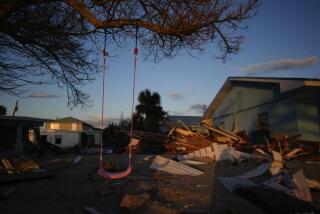Huge Water Wall From Hurricane Lashes Charleston
CHARLESTON, S.C. — Hurricane Hugo, near its mightiest with 135-m.p.h. winds, smacked into the South Carolina coast at midnight Thursday, hurling a thundering wall of water against the historic city of Charleston.
Phone communication ended abruptly minutes before the storm lurched ashore. Ocean swells surged over a stone seawall that braced in vain against the fury of the storm.
Just before landfall, disaster officials warned that Hugo would speed straight through the city’s storied harbor and slam into Ft. Sumter, where the first shots of the Civil War were fired.
“It’s headed for our throats,” said City Council Chairwoman Linda Lombard. On the city’s only operating TV station, she encouraged those who did not evacuate: “Hang in there. We’re with you. You’re going to make it.”
Worse Than Warning
The storm was worse than the warning. It savaged the low-lying peninsula that juts out between the Ashley and Cooper rivers and threw sea water as far as 10 miles inland.
All the handsome, antebellum mansions near the waterfront--many of them impeccably preserved and restored--were hard hit.
Hugo’s landfall came at Isle of Palms, one of the barrier islands just southeast of the city. The hurricane ripped apart a two-lane bridge connecting Palms to the mainland, leaving it swinging by its hinges. “That bridge is spinning like a top,” one witness said.
Within minutes, the full force of the hurricane was in Charleston itself. The command center for the emergency management team collapsed at City Hall, a graceful 188-year-old building. Torrents of water poured into the paneled council chamber.
Part of the roof of the five-story office building that houses the American Red Cross was blown away. Emergency workers huddled inside.
“This building is coming apart . . . “ Liz Leopard, one of the workers, shouted over the phone before the lines went dead. “Glass is falling all over the place . . . . The wind is screaming. It’s just screaming.
“I took a glance outside and there’s a wall of water. It’s literally a wall of water surging across the street and we’re at least 10 miles inland.”
Fires streaked across the night sky in Moncks Corner, 25 miles to the north. Falling trees trapped people in their homes.
“They’re frightened and they want to get out, but the only thing we can tell them to do is just stay there,” Police Chief Greg Hoover said.
“It’s absolutely too dangerous to send anyone out there . . . . We’ve got flooding, we’ve had transformers blowing out all night and we’ve had fires. We just got word that part of a roof blew off at the high school . . . . “
Feared for a Generation
Hugo had become the storm feared for a generation, a monster, one to savagely test the resorts, fine homes and high-rise condominiums that have edged up to the shoreline of the Southeast’s recently developed barrier islands.
Rising water quickly inundated those fingers of land--Folly Beach, James Island, Sullivan’s Island, Capers Island. Electricity went out for miles around.
Hugo’s landfall came within two hours of high tide. The ocean surged beneath it, leaping onto the coast with what the National Hurricane Center said was most likely a 17-foot mound of water. The timing was devastating.
So was Hugo’s aim.
Charleston is one of America’s great gems, almost an 18th-Century etching come to life. Block upon block are filled with preserved and restored churches and homes. The architecture is stunning, from Georgian to Federal, Greek Revival to Queen Anne.
“People feel like Charleston is part of history, and they’ve nurtured it all their lives,” John Price, a retired bank auditor, said just before the storm hit. “Now there’s a lot of terror in people’s hearts. This hurricane can wipe all that out overnight.”
Category 4 Storm
The cost was expected to be staggering. Hugo’s was a Category 4 storm, the biggest to hit the United States since Camille, which bulldozed the Mississippi coast in 1969. Camille killed 255 people and left $1.4 billion in damage.
Officials hoped Hugo’s human cost would not be similarly tragic. “They did an excellent job of moving people to safe shelter,” Bob Sheets, head of the hurricane center, said.
Once the hurricane leaves Charleston, its destruction will be far from over. The coastlines of north Georgia and the Carolinas are some of the flattest along the eastern shore. Hugo carries with it 5 to 10 inches of rain--and the risk of flooding in dozens of inland counties.
The waters will sluice through Southern states first, but then as the storm moves on--even though sapped of strength over land--it will soak populous areas throughout the Northeast seaboard during the weekend, Sheets said.
The storm measured 500 miles across, wider than the coastline of the Carolinas themselves. Its eye was 30 miles wide.
Early Thursday, South Carolina Gov. Carroll A. Campbell Jr. declared an emergency, and ordered the coast evacuated. The National Guard helped move people to safety. “All we can do now is watch and wait,” Campbell said.
By and large, the exodus seemed orderly. The seaside resort of Myrtle Beach was almost deserted by mid-afternoon. Stragglers watched the angry, gray seas rise along the waterfront as police sirens urged them to take heed.
Most homeowners had boarded up their windows before leaving, but North Myrtle Beach Fire Chief Dick Cote remarked sadly: “Their houses may not be there when they get back.”
Makeshift Shelters
Hundreds crowded into makeshift shelters, such as the one at the Myrtle Beach Middle School. Eddie Bolton, the principal, had laid in three days’ stock of frozen foods and “a whole lot of peanut butter and jelly.”
Children cheerfully chased each other through the halls. Adults played cards or did crossword puzzles. They traded anxieties under the school’s awning, smoking the cigarettes forbidden them inside.
Some could recall Hurricane Hazel, which wiped out the city in 1954. Remember, that was before all the buildings went up, they told each other. And besides, Hazel was much slower and smaller than this storm.
Up and down the coast the drill was the same. In Hilton Head, the luxury hotels and vacation villas closed up so rapidly that traffic clogged the causeway--though, as always, a few people refused to go.
“We have an 80-year-old woman who’s out nailing plywood to her windows,” said Dick Vallandingham of the county emergency team. “She’s been through hurricanes before. She says she’ll go through this one.”
In Charleston, the 188-year-old City Hall was boarded up in the morning. “It’s very important that no one underestimate the danger of this hurricane,” Mayor Joseph P. Riley Jr. warned.
Most did not. The photos from Puerto Rico and St. Croix and Guadeloupe were too vivid. Hugo already had claimed at least 26 lives, and most here realized they were fragile against this vicious, arbitrary tempest.
Before darkness, almost half of Charleston County’s 280,000 residents had sought space in a shelter or left the area, said Francis Miller of the disaster preparedness center.
Thousands of cars and vans formed a solid chain along Interstate 26 all the way to Columbia, 100 miles west. Among them were emergency vehicles ferrying hospital patients. Roadside motels were full.
One who fled was Janis Gantman, leaving her home on nearby Kiawah Island. How could she do otherwise? By noon, the waves were reaching 20 feet.
“It’s absolutely awesome,” she said. “It’s scary in just not being able to know if your home will be there when you get back.”
Navy, AF Move Out
In Charleston, the Navy sent its ships to sea to ride out the storm. The Air Force dispatched its planes to more serene skies elsewhere.
Radio stations broadcast urgent orders for National Guardsmen to report to their posts. In between, one station carried a commercial for a plate-glass merchant. “Storms can cause severe glass damage,” it said. “Keep us in mind.”
Those who stayed put in their homes stocked up on essentials. “They’re buying me out of all my candles, tape, flashlights, propane fuel, oil and lamps,” said Tim Brindley, manager of the K mart in nearby Mt. Pleasant.
For most of the day, hurricane warnings reached from north Florida all the way to Cape Hatteras, N.C. Gov. Joe Frank Harris of Georgia also ordered evacuation of coastal areas.
But even those cities and towns spared Hugo’s full wallop were sensing its fierce presence, especially those along the lower North Carolina coastline. Headed their way is the north part of the storm, bearing some of the meanest winds.
Mandatory evacuations were ordered for the southernmost North Carolina counties of Brunswick and New Hanover. “When water starts under the door, that’s too late,” said B. H. Woods, the police chief of Carolina Beach.
In Georgia, the city of Savannah breathed a late-in-the-day sigh of relief. It had been the bull’s-eye on Hugo’s target for most of Thursday.
Savannah prides itself on preparation. City phone books have evacuation plans. People are assigned routes depending on their zip codes. Thursday, they followed orders pretty well.
Oddly enough, some of the recent groundwork was prompted by an Australian “astro-meteorologist,” Jennifer Lawson. In June, she forewarned that a major hurricane would hit the city between Sept. 20 and 25th.
This frightening prediction won so much play in the local news media that planning for a big storm was refined, County Manager Russ E. Abolt said.
All day, hotels were emptying of tourists and filling with residents who wanted the safety of a large building. There were crowds at the front desks.
This is peak season for bus tours throughout Georgia and the Carolinas. Lois Kelsey of Tauck Tours was supposed to be taking a group from Savannah to Hilton Head Thursday morning. Instead they retreated to Atlanta.
“I met with them all last night and there was a consensus: let’s get out of here,” she said. “At least in Atlanta, we’ll be safe.
“Maybe later we’ll go on to Charleston. Of course, if Hugo hits Charleston there will be nothing to see.”
Melissa Healy reported from Myrtle Beach and Doug Jehl from Charleston. Also contributing to this story were staff writers Larry Green in Savannah, Ga., Robert L. Jackson in Brunswick, Ga., and Anna M. Virtue and Barry Bearak in Miami.
More to Read
Sign up for Essential California
The most important California stories and recommendations in your inbox every morning.
You may occasionally receive promotional content from the Los Angeles Times.











